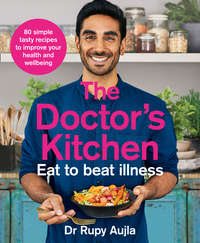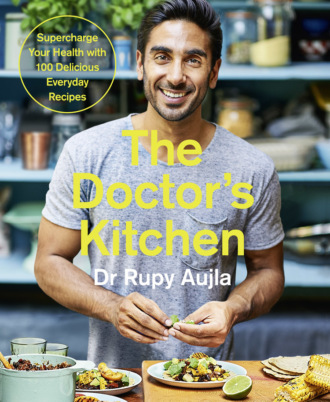
Полная версия
The Doctor’s Kitchen: Supercharge your health with 100 delicious everyday recipes
Alkaline diet
I’m going to give you some insight as to why there is such a divide between physicians and the wellness industry. When non-medically trained, self-styled, health ‘gurus’ are given a platform to influence people into believing they can change their blood pH with a diet high in alkaline foods, it is incredibly frustrating. You can change the pH of your urine using food, but the suggestion that this diet has a miraculous, transformational total-body effect is a huge oversimplification of the science.123
Fundamentally, this diet encourages us to eat more dark green leafy vegetables and generally healthier foods, which isn’t a bad thing.124,125 However, people deserve to be educated and told the truth about how food interacts with our biochemistry, instead of being duped into thinking this is how our bodies work. When you’ve spent time in intensive care, learnt about the complexities of acid-base balance in ill patients and tried to get your head around how complicated pH control is,126,127 you can understand why the use of alkaline theories to promote products annoy doctors all round. We have intelligently evolved organs that precisely control our blood pH using mechanisms that still continue to amaze me.
Introducing ‘alkaline’ foods such as brassica vegetables and colourful fruits is fantastic, but rather than just focusing on ‘alkalinity’, we should appreciate the phytochemical content, the fibre and micronutrients like folate and magnesium. We also need to consider the relatively low sugar content and the endless chemicals that we haven’t yet fully investigated. Focusing on ‘alkalinity’ confuses the matter and I fear it will create an obsession among patients akin to calorie counting. I am an open-minded doctor, so perhaps one day we will learn more about ‘alkalinity’, but for now the science just does not support these claims.128,123,129 I would have great reservations for the liberal use of these ideas, especially by those who cannot appreciate the scientific controversy.
Low Fat/Slimming World/NHS Choices
The medical profession’s obsession with reducing the fat content of our food and encouraging processed, low-fat options over the past few decades has probably been the most effective, yet destructive, health campaign of all time. It’s a message I myself have been guilty of promoting. An over-indulgence in calories, particularly from fat, combined with apathy toward exercise was the generally accepted explanation for why patients were overweight and sick. It was arrogant and naïve to accept this assumption that gluttony was the underlying cause of patients’ illnesses and not question its legitimacy. It’s obvious, now, that this was not correct.130,131
Hydrogenated fats, ‘cholesterol-lowering’ products and sugar-laden alternatives that we promoted are terrible options for the vulnerable cohort of patients we were trying to help.132–135 The recommendations for extreme restriction of saturated fat, cholesterol and total fat are now becoming obsolete and further analysis is proving fat not to be as detrimental to health as we once thought.136,137 The morbid result of our fixation with replacing fats with refined carbohydrates and sugar is exemplified by our current lifestyle-related disease epidemic.138
However, the restricted fat message still exists, particularly among supporters of plant-based lifestyles. To their credit, some small studies demonstrate remarkable cardiovascular disease reversal and cancer improvement using fat restriction and lifestyle change.139,73 On the other hand, the Mediterranean diet, one of the largest and longest studied of eating habits, comprises three times more fat than ‘fat-restricted’ diets with – again – impressive cardiovascular, cancer and diabetes protective effects.50,48
My honest opinion is that we shouldn’t fear fat. We don’t exactly know why some people thrive on low fat intake while others suffer, but I’m certain it comes down to the individual.140 Your environment, gut microbes and ancestry play a major role in predicting the success of any given diet and lowering your risk of disease, but I believe a good proportion of good-quality fats are essential to health.
+ RETHINKING FATS
Fats, including cholesterol, are vital to the functioning of our brains, the composition of cell structures and essential for hormone synthesis. Reducing them to ‘good’ and ‘bad’ fats completely negates the science and lacks an appreciation for how complicated our bodies are. My belief is that a high-sugar, refined-carbohydrate diet in combination with poor-quality fats is the cause of ill health.141 This toxic blend causes inflammation and a cascade of medical problems thereafter, but like a lot of topics in nutrition, the explanation is fraught with complexity. Our thinking about how dietary cholesterol affects heart disease is also changing.142,143,144 Consuming cholesterol, which is only found in animal products, does not necessarily increase the level of cholesterol found in your blood nor increase your risk of heart disease. I know this is quite hard for a lot of people to accept, given the dietary dogma most of us have been subjected to over the last 40 years, but it is based on evidence. Equally, I don’t recommend people actively try to consume more cholesterol. We need to learn from our past mistakes of damning an entire macronutrient to the extent that people are scared into radically removing it, but what I am witnessing now is a swing of the metaphorical pendulum in the opposite direction! Even though butter has been exonerated to some degree, you won’t find me spooning it into my coffee – I like my Americano freshly brewed without lipid-rich particles floating in it, thank you very much. For simplicity’s sake, I stick to the types of fats found in the Mediterranean diet which is packed with nuts, seeds and, of course, extra-virgin olive oil. My simple mantra to patients is: eat whole food and stay away from anything that’s marketed as ‘low fat’ or ‘a healthier alternative to …’ Your body is worth more than those cheap, tasteless alternatives. Some quality fats to enjoy in the context of a whole-foods diet include those found in flaxseeds, nuts, seeds, avocado, extra-virgin olive oil, butter from grass-fed cows, full-fat yoghurt and delicious dark chocolate.
Veganism
In recent times plant-based eating has become exceptionally popular. A number of documentaries have convinced many people of the supposed health benefits of veganism and the health risks of red meat. They do have a lot of successes to feel smug about, that are well documented in the literature. Lower rates of cancer,145 diabetes,146 cardiovascular disease147… the list goes on. It’s compelling stuff and, obviously, I’m a huge supporter of a diet largely made up of fruits and vegetables, but pure veganism doesn’t come without its caveats. B vitamins are noticeably lacking in vegans, as well as zinc, essential fatty acids and vitamin D.148 Careful supplementation with extra nutrients is something I would advise all 100-per-cent plant-based eaters to discuss with their health practitioner.
Also, it’s important to remember that just because you go vegan doesn’t automatically turn you into a dementia-proof, cancer-kicking superhuman with spotless arteries. If I lived on chips and pasta with tomato sauce I could feel pretty ethically minded about not having killed an animal for my dinner, but I probably wouldn’t live for very long to tell people about it.
Ultimately, I have a deep respect for those who choose to live a life on plants alone, whatever their reasons, but my priority would be to make sure everyone is doing it safely.
Wrapping up
What a lot of these diets have in common is a focus on weight loss as a positive outcome, but is this what we should be striving for? Is weight management a reliable biomarker of general health and should this be the common denominator against which we judge the success of a diet? BMI is such a poor predictor of outcomes yet many studies continue to use this as a standard.149
Everyone has the ability to lose weight, tone up and feel lighter, but sometimes it’s at the expense of health rather than in pursuit of it. I want you to feel ‘well’. I’m convinced that good health, contrary to popular belief, is independent of size and especially weight.150 I think we could all do with a little less emphasis on weight as an outcome and more of a focus on wellbeing. Health and wellness conjure images of slim, vivacious, young 20-somethings, but a focus on this as the ultimate goal detracts from why we are trying to achieve a healthier life. I believe it is for the sum of our daily interactions to be positive in mind and physicality. It is to live a fulfilling and happy life. This doesn’t necessarily correspond to a certain number on a machine, even though an industry, and perhaps even your doctor, is trying to convince you it does. Your focus should be on health goals and habits rather than a physical endpoint.
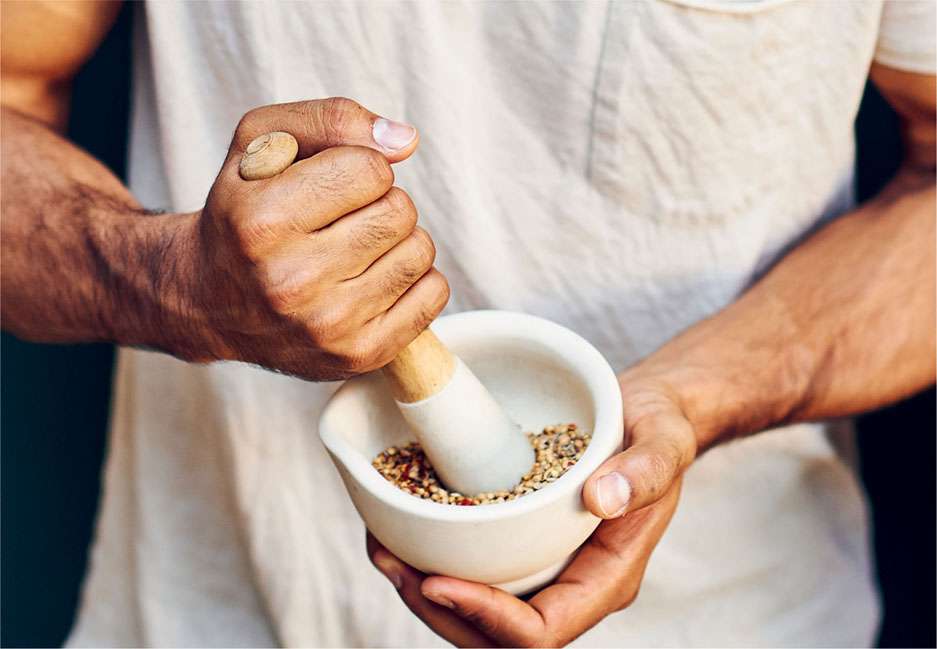
There are endless ways in which you can add nutrient-dense foods to your diet on a daily basis and I want to encourage people to think along these lines. We have an opportunity to be truly nourished, rather than skip from diet to diet in the hope that we hit the ‘carb-protein-fat ratio jackpot’ and achieve that dazzling ‘perfect weight’.
I’m convinced that good health, contrary to popular belief, is independent of size and especially weight.
Medicinal spices

Growing up in an Indian household, I was constantly surrounded by spices, herbs and folk medicines. Everything from sore throats to constipation seemed treatable with the contents of our kitchen cupboards!
Most second-generation kids will concur: Indian families seem to have an encyclopaedic knowledge for complementary health cures. I have vivid memories of being fed a spoonful of toasted spices and salt whenever I had tummy ache. My father would always make a mixture of almonds, clarified butter and sugar during my exams, claiming it was ‘brain food’. And, of course, my mother was years ahead of the ‘Spiced Turmeric Latte’ trend.
You can imagine the number of ‘I told you so’s’ I got when I started researching the clinical validity of traditional treatments. My Indian heritage is steeped in Ayurvedic tradition and what fascinates me is the premise of ‘alternative therapies’ having the potential to become recognised treatment in the battle against chronic disease. Learning about the marriage of flavour and medicinal property was revolutionary for me.
The positive clinical effects of food are unlikely to be caused by a single ingredient, like a spice or herb, so it’s important to maintain a holistic perspective. Remember that any benefit from the inclusion of an ingredient has to be taken in the context of a ‘good diet’. Reiterating what I stated at the start of this book: do not treat food like a pill. Concoctions from herbalists or ‘natural’ food supplements are not panaceas or cure-alls, in exactly the same way that anti-diabetic medications will not manage a patient’s condition if they don’t make changes in their lifestyle to complement treatment. Nonetheless, this does not stop me getting excited about the incredible effects of spices.
Spices make food visibly enticing by adding colour and enhancing the flavour and aroma of the most uninspiring ingredients. Using precise techniques, we can quantify their high antioxidant capacity and activity, which explains why we’ve used spice as a preservative for centuries. There is enough evidence to support the daily inclusion of nature’s wonderful spices and here are some staples I believe everyone should have in the store cupboard and the clinical evidence as to why.
Turmeric
Turmeric is probably one of the most extensively researched spices we have in nutritional science and it’s now commonly accepted that daily dietary inclusion can prevent bowel cancer. There’s also evidence that it could be beneficial for helping dementia, chronic pain syndromes and inflammatory conditions.151 It’s astonishing what effects a single ingredient can potentially have on the body.
As is usually the case in nutritional therapy, supplementation using high doses of one of turmeric’s active compounds, ‘curcumin’, has had mixed results.152,153 Turmeric is not just curcumin. The spice is made up of hundreds of different plant chemicals of which curcumin is just one. These studies teach us a lesson: use whole plants as much as possible rather than isolated chemicals. A single component is not likely to be responsible for their health benefits; it’s the complex arrangement of molecules in whole ingredients that we find in nature.
Herbs and spices
These are some of my favourite herbs and spices to use when I’m cooking. I always have these in my kitchen and I highly recommend that you get as many of them as you can into your diet.
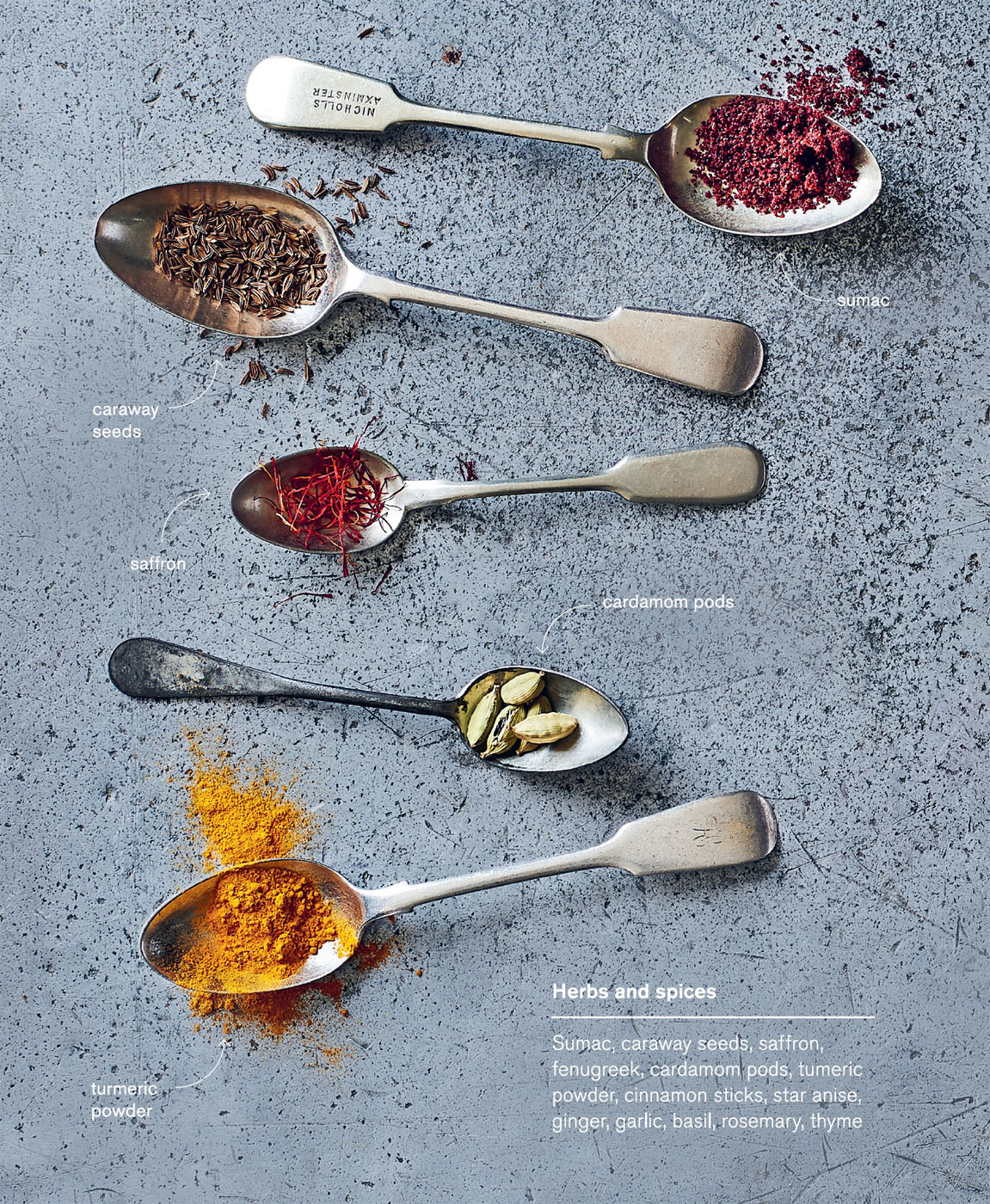

I use ground turmeric in everything from Malaysian curry pastes to soups and stews; and if you can get hold of the fresh stuff that looks like ginger with bright orange flesh, even better. Using fresh turmeric in cooking with other ingredients like chilli and black pepper (that contain capsaicin and piperine) heightens its effect and availability in the body.154 If nothing else gets you interested in ‘food as medicine’, this herbaceous plant from the ginger family should.
Garlic
I’ve been raised to expect garlic to be used in most dishes cooked at home. But even now, whether I’m cooking Italian, Chinese or Moroccan food, garlic forms the flavour base for most of my meals. Enough research has been published for me to believe that it can lower your risk of cancer, and laboratory studies demonstrate its anti-bacterial and anti-viral properties.155–158 It may have a positive impact on human gut microbe populations159,160 too, and it’s so easy to incorporate into meals. It’s definitely an ingredient I get into my food on a daily basis (you’ll notice how often it’s used in my recipes).
Garlic is also so versatile. You can simply cut the top off a whole bulb, drizzle it with olive oil and roast it for 20 minutes, squeezing the cooked pulp out of its papery skins and storing it in the fridge. I use it as a spread or flavour enhancer when making quick meals. Look out for fresh, smoked garlic and my current favourite, black garlic: it has a sweet balsamic vinegary taste and is a wonder ingredient in pesto and sauces.
Ginger
Here’s another spice often used in Indian cooking, with a host of studies examining its effect on everything from cancer prevention to nausea.161,162 Gingerols, shagoals and zingerones are all antioxidants thought to be responsible for its health effects.163 I use fresh ginger as much as possible for its pungent taste and powerful volatile compounds. It’s a staple base for lots of my recipes and sometimes I’ll boil some up with honey to treat a sore throat. There are many innovative ways to use ginger in drinks, tonics, sauces and curries. My recipes will show you how easy it is to get this marvellous spice into your system.
There are well recognised polyphenol compounds in ginger and it’s been suggested in the research that we class it as a functional food because of its effects on the body. I use it in my Medicinal Broth (see here), I pop ginger skin into tea, I grate it into Asian-style dressings (see here) and it’s cheap and available to everyone. Get it into your kitchen.
Sumac
This vibrant burgundy-coloured spice has the most wonderful, warm citrus flavour. It’s used in Iranian and Turkish cuisines in tagines and stews or simply to garnish plates with a sour note. It also happens to be one of the most antioxidant-rich ingredients on the planet.164,165 It’s been used in traditional medicine to treat everything from diabetes166 to cardiac disease, but unfortunately the extent of research we currently have to support these claims is mainly performed in a petri dish or on animals.167 The research is one to watch.168
Made from drying a species of the plant genus Rhus, sumac is generally underutilised in cooking, but I use it all the time for its incredible flavour profile and vibrancy. A sprinkle will transform everything from poached eggs to natural yoghurt. Try it out in some of my Middle Eastern-inspired dishes (see Persian Chicken Thighs here, and Spicy Baked Eggs here).
Cumin
Cumin is a functional spice that contains myriad compounds thought to be anti-bacterial and blood-sugar regulating (among many other claims of traditional medicine).169 Unfortunately, again, there are not many human clinical trials examining the exact effect of this spice and when there are, they’re not conducted well.170 What we do know is that it contains a really high antioxidant capacity as well as particular compounds that have been implicated in reducing inflammation and fighting cancer.169,171,172
I couldn’t cook without cumin (or ‘jeera’, as it’s known in my kitchen). Used as ground seeds or whole seeds, it has an assertive taste that is distinctly Indian in my mind, but is very easily incorporated into a variety of dishes. Use it to transform your roast dinners, spice up your omelette or add an exotic hint to any meal. And, if you use it frequently, buy a bag of it from your local Indian store, not a thimble-sized jar!
Cinnamon
Another aromatic, antioxidant-packed, flavour bomb. The compounds in cinnamon have been investigated in order to explain why this spice has anti-inflammatory effects and improves metabolic syndrome.173 Study after study reports potential mechanisms of action, and the biology, for someone interested in why spices have medicinal benefits, is groundbreaking. Reading some of the texts is like going back into pharmacology lectures at medical school. It’s a fascinating field of research that I hope will unravel more information, but for now, experiment with cinnamon in my spices, dressings and pastes (see here) to elevate simple dishes.
Its versatility permeates through savoury and sweet dishes, drinks and dressings, modern European cuisine to rural Indian meals. It’s no wonder cinnamon used to be more valuable than gold in Egyptian times. Invest in a large, high-quality tub of it – you cannot have a kitchen without this spice.
Basil, rosemary, thyme
The incredible health properties of herbs and spices are not exclusive to those shipped in from the Far East or Africa. We have some amazing flavour enhancers that are easy to grow here in the UK in a pot in the kitchen, and that have as much functional benefit as the most expensive and beautiful saffron from Iran.
Basil, rosemary and thyme may seem unassuming, but the library of chemicals held within their leaves is inspiring. At the average ‘doses’ that we tend to use in cooking, they contain exceptionally important dietary sources of chemicals that reduce oxidative stress and attenuate inflammation.174 The theories of heightened inflammation and its role in lifestyle-related disease, such as blood pressure, stroke and diabetes, is very fashionable in medical conferences these days.175 Any inclusion of foods that can reduce our inflammatory burden is welcome, and these delicious, cheap, widely available herbs are worth every stalk.176
Adding roughly chopped basil to Italian recipes adds an extra depth of flavour. Thyme, perhaps one of the first herbs to be recognised for its medicinal qualities, is in everything, from my fresh barbecue rubs (see here) to my twist on shakshuka (see here). Pestos, marinades, green curry pastes, aioli … the options are limitless and, as a doctor, I cannot recommend highly enough that you include these herbs in your daily diet.
Any inclusion of foods that can reduce our inflammatory burden are welcome, and these delicious, cheap, widely available herbs are worth every stalk.
Seeing past the herb garden
We really need to start investigating spice compounds further. We know that they are safe for consumption because we’ve essentially been testing them by including them in our diets for years,177 and exciting early research suggests a potential role for their use in treating different conditions.22 Don’t get too fixated on the exact amounts of antioxidants or measurements of compounds in an individual spice. First, not all the evidence looks at specific ‘dosing’ of ingredients, and second, they have varying effects in our body. The best advice is to consume a complement of different herbs and spices daily. Their synergistic effects have been shown to heighten their physiological properties,173 as well as adding a delicious complexity to food.
These are some of my favourite spices, but it’s by no means an exhaustive list. I’ve also written a section on spice combinations in the recipes section (see here) to help you get creative. Label your own spice blends – it’ll impress your friends and help get kids into the kitchen!
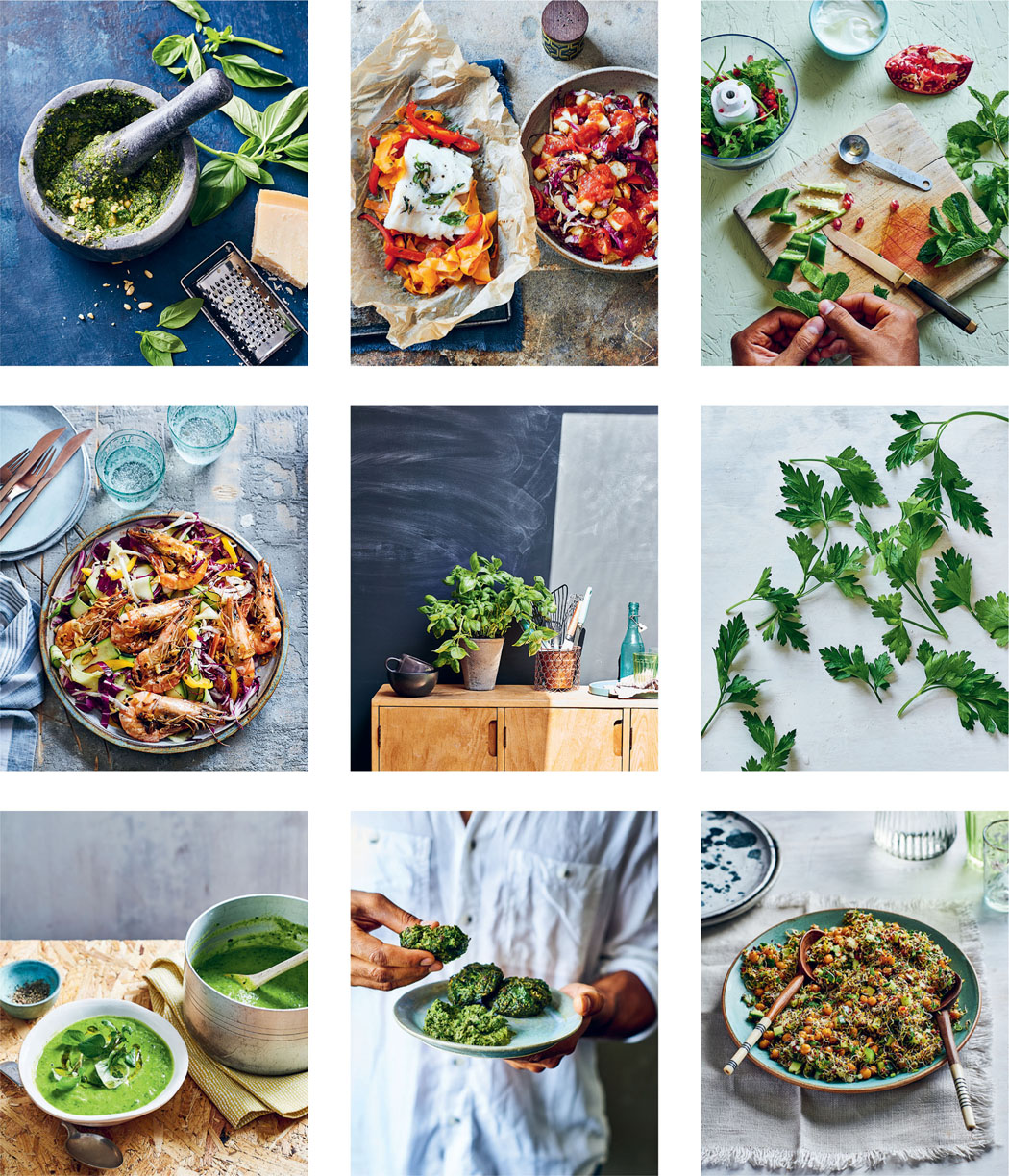
Worth the extra spend?

Patients often ask me whether they should spend money on ‘health foods’.
I’m encouraged by the fact that more people are interested in food, experimenting with different ingredients and at least attempting to live healthier lives, but the ‘superfood’ trend has its downsides. It has tainted the image of organic as something only attainable for conscientious middle classes, and perusing the aisles of ‘health’ sections in major supermarkets, you can forgive people for thinking eating well is costly. Some ingredients that caught media attention in recent years are incredibly expensive, and are backed by ‘research’ which is questionable in a lot of cases. I often get asked ‘which ones are worth the money’?
As a foodie, I’ve probably tried most of them. But, importantly, I judge them on the evidence base of their supposed health benefits as well as their taste. If we choose to spend an exorbitant amount of money on these ingredients, they’d better be worthwhile! Bitter gourd juice has been shown to improve glucose control in diabetics, but the taste is frightful! And I can’t see Western palates taking to ‘Amla’ powder any time soon.
However, the following ‘health’ ingredients, add flavour and texture and I believe are worth the extra pounds on your weekly shopping bill.
Hemp seeds
These are one of the most concentrated sources of plant-based protein available. The seeds have a whopping amount of fibre and a great fatty acid profile to make them a potentially heart-health-promoting product.178,179 The Omega-3 fatty acids they contain are an important source of fats for largely plant-based eaters like myself.178
The nutty and slight oily texture of the seeds makes them a great addition to smoothies or granola, and toasted with spices they make an awesome salad topper. The seeds are easier on your digestion than most processed protein powders and far more nutritionally dense.180 In fact, I don’t use protein powders any more in my post-workout smoothies because shelled hemp seeds are brilliant and, on balance, much cheaper than those outrageously large tubs I used to buy.
Cacao powder
Raw cocoa beans are roasted and ground to create this bitter, antioxidant- and flavanol-rich product that I use in everything from Mexican Mole (see here) to vegan ice cream. Most people aren’t aware of its incredible amino acid profile. It’s a complete protein (i.e. it contains all nine essential amino acids) and its phytochemical profile is off the charts!181 It’s thought to potentially reduce the risk of stroke,182 elevate mood by preventing tryptophan destruction183 (an amino acid used in synthesis of the neurotransmitter serotonin) and improve cardiac function by increasing nitric oxide levels in the blood.184 It is even suggested that cacao has a positive effect in neurocognitive disorders like dementia,185 but while I welcome this fascination surrounding polyphenol-rich foods, I wouldn’t get too overexcited. Cacao may have potential applications in the future of medicine, but for now, let’s focus on its culinary uses!




